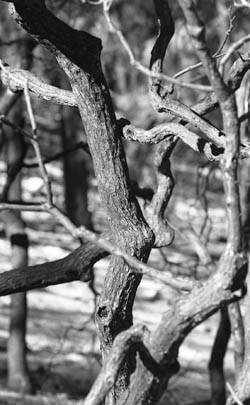|
McInnis proposes trimming environmental
regulations and logging fire-prone forests
by Will Sands/Photos by Jamie Morehart

The threat of wildfire could be erased by an unlikely source –
logging – or at least that’s what U.S. Rep. Scott
McInnis, R.-Colo., believes. McInnis is currently pushing a bill
through a deadlocked U.S. Congress that would speed the rate at
which timber projects are approved by eliminating the length of
environmental review. Whether his Healthy Forests Reform Act would
make for healthy forests is widely disputed, though local forest
officials are inclined to side with McInnis.
It’s no secret that Durango,
La Plata County, Colorado and the American West in general were
racked by wildfires this summer. The Missionary Ridge fire, the
largest La Plata County blaze and the biggest impact on Durango,
scorched 70,662 acres, swallowed 56 homes and came within five
miles of the Durango city limits.
On Sept. 4, McInnis responded
to this and other devastating blazes with the Healthy Forests
Act. Saying that mitigating the future threat of wildfire requires
“bold and decisive steps,” McInnis proposes increased
logging on 10 million acres of fire-prone, federal lands by relaxing
environmental restrictions.
“We feel this bill is
the middle ground and will bring about reform on how we manage
our forests especially relative to catastrophic wildfires like
we saw with Missionary Ridge,” said Blair Jones, McInnis’
press secretary. “The bill would reduce the threat of wildfires
to communities, wildlife habitats and watersheds. That should
be of particular interest to the people of Durango with the recent
drinking water contamination that Bayfield had to experience.”
Currently, logging and other
private activities on public lands are governed by the National
Environmental Policy Act (NEPA). According to Jones, timber sales
can get bogged down by this environmental analysis for years and
consequently, forests are not adequately thinned against the threat
of wildfire.
“This bill would allow
emergency-arrangement designations to be put in place where conditions
for catastrophic wildfires exist,” Jones says. “The
bill would still allow for the opposition to challenge these projects.
But we’re creating a review process where decisions will
be made in a few months instead of a few years.”
Slipshod scoping?
While there is universal agreement
that La Plata County and the West in general would like to avoid
another catastrophic wildfire season, there is some doubt that
McInnis’ bill would do that. Mark Pearson, executive director
of San Juan Citizens’ Alliance, says that the bill will
essentially streamline environmental review and cut the public
out of management of public lands.
“Mostly, what it’s doing
is trying to eliminate public involvement as much as possible,”
Pearson says. “It essentially cuts in half the amount of
time for public scoping. Overall, we’d characterize it as
encouraging slipshod analysis with vastly limited public input.”
Pearson adds that while this summer’s
fires were devastating, they were unusual, and forest policy should
be set using a more historic perspective. “It doesn’t
seem like the best idea to set forest policy on an extreme event
like a 100-year drought,” he says.
Pearson also is quick to note that
the main culprits in wildfires are brush and small-diameter trees,
neither of which are profitable to loggers. “Our worry is
they’ll start throwing more and more big trees to make it
more economically attractive, and they’ll start perverting
the whole purpose that way,” he says. “Ultimately,
all the oak brush and small-diameter pine is difficult to make
into a commercial product.”
Logging our way into wildfire
Tammy Tyner owns Timber Tech West,
a Durango company that specializes in thinning forests for wildfire
mitigation, and forest restoration. The restoration efforts are
directed entirely at trying to return areas that have been clearcut
to pristine states. Tyner says that irresponsible logging practices
have led to the dangerous wildfire conditions that exist today.
“High-grade logging is absolutely,
100 percent irresponsible,” she says. “We’re
going to have to be very careful if we let loggers come in. They’re
part of the reason we’re in the state we’re in.”
Rather than encouraging logging by
streamlining environmental regulations, Tyner suggests that the
Forest Service may have to carry the load of mitigating fire danger.
“What we need to do is to be able to subsidize people going
in and cleaning up the forest,” she says.
When asked how McInnis’ bill
would address this needed understory removal, Jones replies: “Our
focus in the bill is to reduce the fuel loads. Nowhere in the
bill does it speak to the quality of the logging. Plus, to ensure
that what we’re promoting is working, we’re establishing
a monitoring process.”
(continued...)
|

